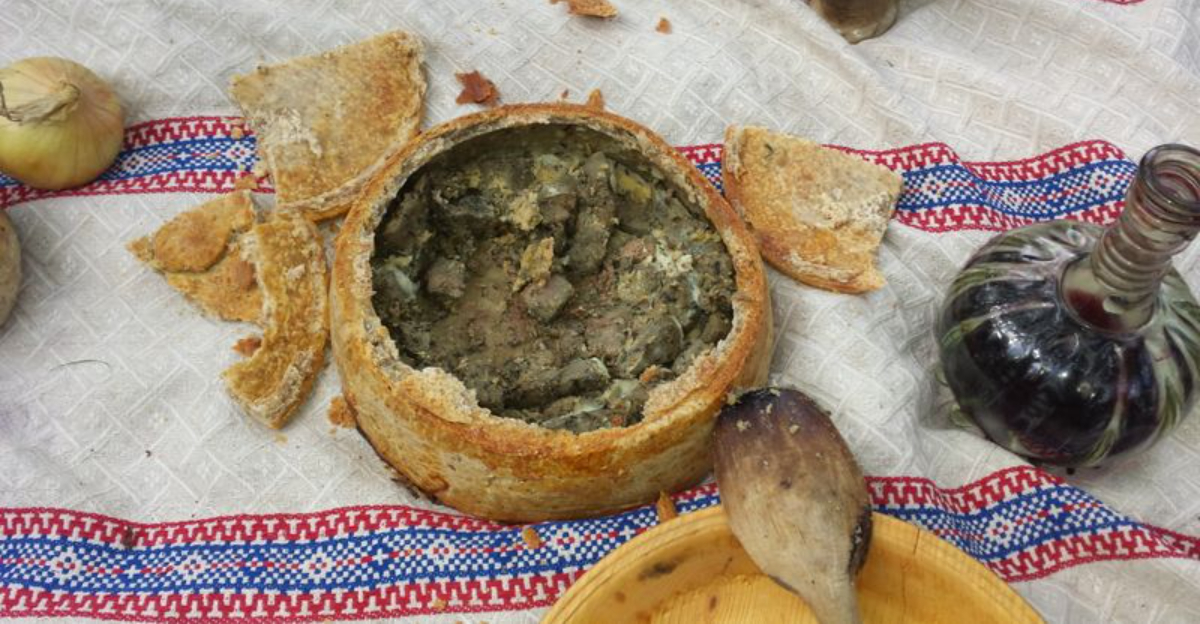15 Meals From The Middle Ages That People Are Trying To Revive

Medieval meals weren’t all about bland gruel and turkey legs.
Knights, peasants, and royalty actually enjoyed a surprising variety of flavors and cooking techniques that modern foodies are rediscovering. Food historians and adventurous chefs are bringing these forgotten recipes back to life, finding that our ancestors knew a thing or two about creating memorable meals.
1. Pottage – The Medieval One-Pot Wonder
Forget instant ramen! Medieval pottage was the original comfort food that kept bellies full through harsh winters. Peasants tossed whatever vegetables, grains, and occasional meat scraps they had into a perpetually simmering pot.
Modern versions feature seasonal veggies, heritage grains, and bone broth for extra flavor. Farm-to-table restaurants have embraced this humble dish for its sustainability cred.
2. Blancmange – Silky Almond Delicacy
Though sharing a name with its wobbly modern descendant, medieval blancmange was a luxurious dish for the wealthy. Almonds (crazy expensive back then) were ground into milk and mixed with rice flour, sugar, and sometimes chicken.
Today’s food historians recreate this silky concoction as a dairy-free alternative that predates modern plant milks by centuries. Who knew medieval monks were basically hipster baristas?
3. Hippocras – Spiced Wine Elixir
Hippocras wasn’t just booze, it was medieval medicine! Named after Hippocrates himself, this spiced wine contained cinnamon, ginger, and grains of paradise, strained through special cloth bags called “Hippocratic sleeves.”
Craft cocktail bars now feature this ancient beverage as a seasonal special. Wine enthusiasts love its complex flavor profile that makes modern mulled wine seem boring by comparison.
4. Mawmenee – Fruity Wine Celebration
When medieval royalty wanted to party, mawmenee hit the table! This sweet, thick concoction mixed wine with ground almonds, sugar, and exotic spices, creating a dazzling purple celebration dish.
Culinary archaeologists have revived this showstopper for museum events and historical dinners. Though wildly different from modern desserts, its fruity-spicy profile surprisingly appeals to contemporary palates looking for something beyond chocolate cake.
5. Frumenty – Ancient Wheat Berry Porridge
Move over, overnight oats! Frumenty was the medieval breakfast champion, made from cracked wheat berries simmered until tender, then enriched with almond milk, saffron, and sometimes egg yolks.
Health-conscious foodies have rediscovered this ancient grain dish as a protein-packed alternative to modern cereals. Whole food enthusiasts appreciate its simple ingredients and warming comfort – perfect for cold mornings.
6. Compost – Medieval Mixed Fruit Preserve
No, not garden waste! Medieval compost was actually a delicious preserved fruit mixture similar to modern chutney. Dried fruits, nuts, and spices were preserved in honey or wine, creating a sweet-tart condiment that lasted through winter.
Artisanal preserve makers have brought back this versatile spread. Unlike our single-fruit jams, compost’s complex flavors pair brilliantly with everything from roasted meats to aged cheeses.
7. Cockatrice – Half-Pig, Half-Chicken Fantasy
Talk about food with flair! Cockatrice was pure medieval food theater, a mythical beast recreated by sewing together the front half of a roasted chicken and back half of a suckling pig.
Modern chefs at historical banquets love this showstopper for its dramatic presentation. While definitely not an everyday meal, this Instagram-worthy creation demonstrates how medieval cooks understood the importance of eating with your eyes first.
8. Civey Of Hare – Sophisticated Game Stew
Hunter-gatherers rejoice! Civey of Hare was the medieval equivalent of gourmet wild game cooking. Tender rabbit or hare was slowly simmered with onions, red wine, and a unique blend of spices including cinnamon and cloves.
Farm-to-table restaurants specializing in game meats have revived this sophisticated dish. Its rich flavors and sustainable protein source appeal to modern diners seeking alternatives to factory-farmed meats.
9. Tarte Owt Of Lente – Medieval Custard Pie
Sweet teeth existed long before modern candy bars! This indulgent custard pie combined almond milk, rice flour, sugar, and saffron into a golden delight served during non-fasting days (hence the name “out of Lent”).
Bakeries specializing in historical recipes have brought back this dairy-free wonder. Its beautiful yellow color comes from expensive saffron – showing that medieval folks would splurge for special occasions just like we do!
10. Mortrews – Meat-Bread Power Pudding
Mortrews existed before protein shakes! A thick, filling pudding made from finely ground beef, breadcrumbs, eggs, and spices, this robust delicacy fed both knights and workers.
Fans of modern nose-to-tail cooking value this waste-free method of preparing meat. Its savory flavors and sustainable approach to meat consumption feel surprisingly relevant today, even though its texture may surprise modern diners.
11. Salat – Not Your Boring Side Dish
Medieval salads would make modern health influencers swoon! Unlike our boring lettuce bowls, medieval “salat” featured edible flowers, herbs, nuts, and sometimes preserved fruits dressed with oil and vinegar.
Foraging chefs have revived these colorful creations featuring forgotten edibles like purslane and borage flowers.
These Instagram-worthy dishes prove our ancestors understood both nutrition and presentation centuries before food photography.
12. Caudel – The Original Recovery Drink
Move over, sports drinks! Medieval caudel was the original recovery beverage, served to new mothers, the elderly, and the sick. This warm, strengthening drink combined wine, egg yolks, sugar, and spices into a custardy comfort.
Wellness-focused cafés have begun offering modern versions as immune-boosting elixirs. Though the alcohol content might raise eyebrows today, its protein-rich formulation actually makes nutritional sense for recovery.
13. Stockfish – Medieval Protein Powerhouse
Before refrigeration, there was stockfish!
Cold winds caused this preserved cod to become rock-hard, extending its shelf life. After pounding it back to life, medieval cooks would boil it with spices and butter.
Proponents of sustainable seafood have rekindled interest in this age-old method of preservation. In order to address contemporary worries about seafood sustainability and maintain a link to their culinary past, Nordic restaurants highlight this traditional staple.
14. Bukkenade – Goat Stew With Exotic Flair
While beef dominates modern menus, medieval folks went wild for bukkenade – a rich goat stew featuring exotic ingredients like cinnamon, ginger, and sour grape juice. The tangy-sweet profile showcased the medieval love of contrasting flavors.
Adventurous chefs working with heritage meats have rediscovered this sustainable alternative to beef. Goat’s growing popularity makes this medieval recipe particularly relevant for environmentally conscious carnivores.
15. Umble Pie – Humble Origins, Rich Taste
Do you know what “eating humble pie” means? In this medieval cuisine, deer innards, known as umbles, were cooked in a savory pastry with dried fruits and spices. In kitchens of the Middle Ages, nothing was wasted!
Nose-to-tail eateries have brought this sustainable meat-eating philosophy back to life. The original’s waste-free attitude and sweet-savory combo may be replaced by more familiar organ meats in later variants.
